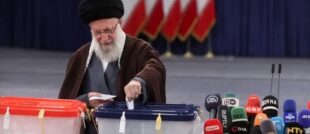Iranwire – The snap presidential election in Iran, held on Friday, saw Masoud Pezeshkian and Saeed Jalili emerge as the top candidates, moving on to the runoff stage.
The election results and participation levels convey several significant messages.
First: Reconciliation of the People with the Ballot Boxes Requires More Motivation than a Reformist Candidate
The Guardian Council’s decision to approve one of the three main Reform Front candidates, Masoud Pezeshkian, was seen as a move to boost voter participation.
Reformist political parties’ boycott of the parliamentary elections had previously contributed to decreased participation, and it was believed that their involvement in this election would significantly increase turnout.
However, the participation rate remained below 40 per cent, showing an 8 per cent decrease compared to the previous presidential election.
In the last election, 28,989,000 people (48.88 per cent of eligible voters) participated.
This period saw participation drop to less than 25 million (40 per cent), matching the level seen in the parliamentary elections in March.
This demonstrates that merely approving a reformist candidate is insufficient to reconcile the people with the electoral process.
Second: Increasing Participation is Tied to Hope, Not Reformers
The low turnout, despite extensive invitations from reformists to vote for Masoud Pezeshkian, recalls the 2005 defeat of Akbar Hashemi Rafsanjani in the second round of the presidential elections.
During that period, despite calls from reformists and intellectuals to prevent Mahmoud Ahmadinejad’s victory, the majority of people did not respond, resulting in Ahmadinejad winning with lower overall voter turnout in the second phase.
These elections show that hope for change, rather than trust in reformists, drives voter participation.
People engage in elections when they see the potential for change, not merely to avoid unfavourable outcomes.
Reformists and Masoud Pezeshkian must instill hope for change, rather than simply focusing on “getting rid of the Jalili evil.”
Without this, they risk losing the election.
Third: Voting Patterns of Pezeshkian from Raisi and Ahmadinejad’s Ballot Box
The reformists have consistently argued that higher voter turnout is key to their success.
In this election, they frequently stated that if voter participation exceeded 60 per cent, Masoud Pezeshkian would secure a first-round victory.
They believed Pezeshkian had little chance in an election with 40 per cent participation.
However, the results showed that Masoud Pezeshkian’s strategy of focusing on Ahmadinejad’s voter base and appealing to the deprived class paid off.
He won with 40 per cent participation, largely due to the support of fundamentalists and the deprived class, managing to attract a portion of fundamentalist voters.
Ebrahim Raisi won in 2021 with 18 million votes, which matches the combined votes of Masoud Pezeshkian and Saeed Jalili.
This indicates that not all of Raisi’s votes came from fundamentalists. The deprived class, which previously supported Mahmoud Ahmadinejad, voted for Raisi in 2021 and for Pezeshkian on Friday.
Fourth: The Second Round of the Election and the Key to Masoud Pezeshkian’s Victory
Masoud Pezeshkian and Saeed Jalili have progressed to the second stage.
This stage will be challenging for Pezeshkian. A portion of the votes from Mohammad Bagher Ghalibaf and Mostafa Pourmohammadi is expected to go to Pezeshkian, while a larger share will likely support Jalili.
At this stage, Pezeshkian needs to mobilize some of the boycotters to participate.
To achieve this, he must instil hope for change and make promises that resonate with them.
Fifth: Reformists’ Inability to Win the Trust of Women’s Movement Supporters
The presidential election results and the continued boycott by 60 per cent of eligible voters, despite significant participation by reformist political elites, indicate that activists in the Woman, Life, Freedom movement seek a fundamental change in Iran’s political structure.
The reformists, previously successful, have failed to gain this movement’s trust as they have not managed to implement substantial reforms.
The Guardian Council’s approval of a reformist candidate showed the government recognized that increased participation requires reformists.
 Shabtabnews In this dark night, I have lost my way – Arise from a corner, oh you the star of guidance.
Shabtabnews In this dark night, I have lost my way – Arise from a corner, oh you the star of guidance.



